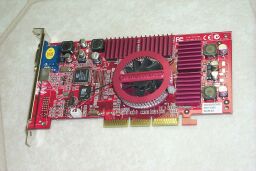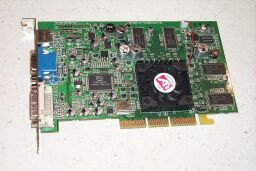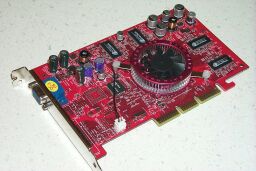| MIXING FRAME-RATES AND FRUGALITY... |
For the 3D performance enthusiast or gamer who can't (or doesn't want to) spend a lot of money on a video card, the challenge is to find a card that offers excellent performance at a bargain price. This becomes particularly important if you upgrade your video frequently (like me), or have a family with multiple PC's in the house (also like me). Fortunately, such hardware isn't all that difficult to find in today's competitive video card market. While it may not be possible to have the "latest, hottest" hardware at a truly reasonable price, you'd be surprised at how close you can get to that level of performance for a WHOLE LOT LESS MONEY!!
Now, if you're one of those guys who just has to have the fastest set-up in town and can't sleep at night if your machine isn't pulling over 10,000 on 3DMark 2001SE, then you should head right over to AnandTech or Tom's Hardware or the-name-of-your-favorite-hardware-site-here and read up on the latest "hot" card coming down the pike. You'll find nothing of particular interest here. Sorry, I'm not going to look at $300 - $400 GF4 Ti4600, Radeon 9700 and Parhelia cards and tell you which one you should buy. But if you'd like to get 85% to 95% of the performance of one of those 3D Ferraris at a Hyundai price, then keep reading...
Let me be clear right up front that I'm going to focus on the meat-and-potatoes 3D performance factors here, and not get into evaluating other stuff like VIVO, DVD playback, built-in TV tuners, etc. Those things have their place, of course, and your particular needs may make them a high priority when selecting a new video card. But I'm going to concentrate on stuff like frame rates and FSAA performance--the things that make games run fast and look good.
One other point that I've made before and repeat here, and I want the reader to understand that this is strictly personal opinion and that I gain NOTHING by making it: If you are in the market for a video card, be sure to stop by NEWEGG.COM and check out their offerings. Their combination of extensive selection, rock-bottom prices, and first-rate customer service makes them the video card vendor of choice, IMO. Check them out at RESELLERRATINGS.COM, and you'll see what I mean. I make these comments as a satisfied customer, having done business with them many times. Now, back to the business at hand....
| SO WHAT'S OUT THERE RIGHT NOW?? |
As of mid-2002, what video cards fall into this magical category of "wicked fast and dirt cheap"? Let me make it clear right up front that I'm not talking about low-end video cards here, or old technology. For example, I consider the Geforce2 or original ATI Radeon cards to be too old now to offer really competitive performance, given the current state of the art in 3D rendering. Nor am I talking about the "value" versions of the newer product lines, like the Geforce4 MX or Radeon 7500. IMO, the performance tradeoffs inherent in the technology employed in these cards limits them from reaching the performance level that the serious 3D enthusiast demands. Instead, I'd like to concentrate on three video card varieties that offer high performance--within "striking distance" of the top-of-the-line cards--while selling at prices that are close to or in some cases below what the newer "value" cards sell for. These three cards are the Geforce3 Ti200, the Radeon 8500LE, and the Geforce4 Ti4200. Of the three examples shown below, it's not necessary to pay more than $150 for any of them, and one of them I just purchased for $94, delivered. Let's have a quick look at each:
The Gainward Geforce3 Ti200:
 |
The NVidia Geforce3 Ti200 cards have been around now since late 2001, and are now one generation behind in terms of 3D technology. Though not up to the performance levels of the newer Geforce4 Titanium cards, they are still very quick and capable video adapters, faster than the newer Geforce4 MX cards, and with more capable overall rendering technology. But their strongest appeal right now is price. With the introduction of the Geforce4 product line, the price of the GF3 cards has fallen considerably, and will no doubt decrease even further. The 64MB Gainward Geforce3 Ti200 pictured at left was purchased from NewEgg for $180 last December, but can be had for a mere $113 now. And though the Gainward card is probably unsurpassed for overall performance, there are several other very good GF3 Ti200's available, some for significantly lower prices. For example, COMP-U-PLUS is currently selling a PNY GF3 Ti200 for $113 with a $30 mail-in rebate, for a final cost of $83. Tough to beat value like that, as long as the 3D performance is good. And we'll look at that factor shortly.
ATI Radeon 8500LE:
 |
Another card that's been around for a while but still stands as a very attractive option is the Radeon 8500LE. Like the the two Geforce cards included here, it comes in both 64 and 128MB versions, though I'm sticking to the former as part of the "bang for the buck" theme of this review. ATI, the maker of the Radeon family of video chips, produces finished video cards as well as selling video chips to other board makers. This distinguishes them a bit from NVidia, who is strictly a chip manufacturer. Because NVidia has pretty much dominated the performance 3D market since the untimely demise of 3dfx in late 2000, ATI has had something of an uphill battle to establish itself as a serious contender. The original Radeon was their first really significant step in that direction, and with the 8500 series, they have been nipping at NVidia's heels. As an underdog, ATI has needed to be aggressive with their pricing as well as competitive with their technology. The Radeon 8500LE was basically their response to the GF3 Ti200, offering excellent 3D performance at very affordable prices. The card shown at left was recently purchased in "bulk" form (card, software/driver CD and TV-out cable, wrapped in bubblepack!) from NewEgg for $94, including free FedEx Saver shipping.
Gainward Geforce4 Ti4200:
 |
Among this small group, the NVidia GF4 Ti4200 is "the new kid in town". When NVidia rolled out the Geforce4 Titanium series of high performance 3D cards, the top-of-the-line Ti4600 and the slightly slower Ti4400 were the first to hit the shelves. It's just been within the past couple of months that the much anticipated Ti4200 has been available. Incorporating the GF4 Titanium rendering technology, somewhat slower clockspeeds, and a cost-reduced hardware configuration, the Ti4200 has quickly gained popularity for its blend of solid performance and reasonable cost. The 64MB Gainward card shown here currently sells for $143 at NewEgg, putting it within the budget range of frugal upgraders. Interestingly, the 64MB GF3 Ti200 cards ship with higher memory clockspeeds than the more expensive 128MB version: 513MHz vs. 444MHz. This is enough of a difference to make the 64MB card slightly faster in many games than the 128MB, though the latter's doubled memory is an advantage in some of the most demanding new games. Of course, all bets are off when you start overclocking....
Speaking of overclocking, that becomes an important consideration for the 3D enthusiast who is trying to squeeze every drop of performance out of a video card upgrade. The good news here is that all three of these cards offer decent or better overclocking potential, further enhancing their value. So as we get into evaluating performance, we'll look at two sets of clockspeeds for each of the three cards--the as-shipped default speeds, and at overclocked conditions. The maximum attainable stable clockspeeds will vary considerably from card to card, even in the same brand. You may find that your particular card cannot reach the core or memory speeds quoted here. Or you may find that you can do considerably better. C'est la vie!
Another factor that we'll need to consider is full-scene anti-aliasing (FSAA) performance. FSAA can dramatically improve the visual quality of many games, particularly racing games and flight sims. Current cards offer a range of FSAA settings, and the trick is to find one that gives you the visual quality you like without degrading rendering speeds too badly. This performance degradation has been an impediment to realizing the full visual quality benefit of FSAA technology in the past, but the situation has been improving steadily. How will it impact this group of cards, particularly the new GF4 Ti4200, which is touted to have the best FSAA technology currently available? We'll see!
So now that we know a bit about "the players", let's see what they can do....
